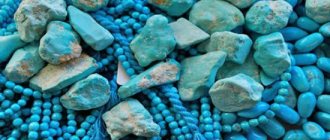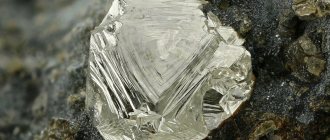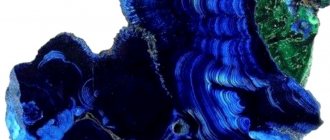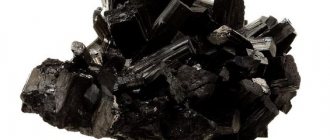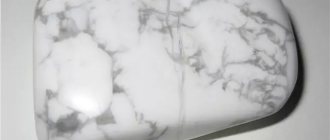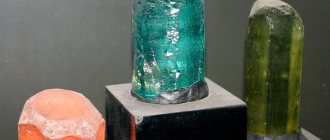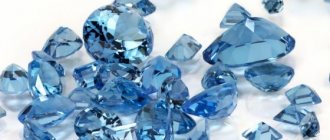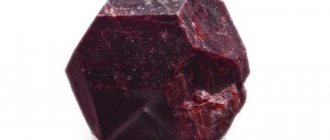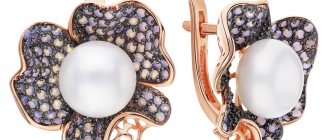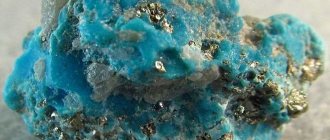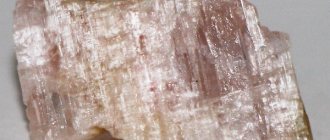Turquoise is rightfully one of the most popular stones for creating jewelry. Although there are many deposits of turquoise, each of them is small in reserves and often turquoise is mined from large copper deposits as a by-product.
As a rule, the price of a jewelry stone is determined by its color, clarity, cut and weight, but in turquoise one of the most important factors is the deposit. Some of the most expensive are specimens from Arizona, Iran, Mexico and Egypt. Mining is also carried out in China (Hubei province), Afghanistan, Chile, Poland, Kazakhstan, Tajikistan, and the external properties of the type of turquoise differ depending on the deposit.
Chinese turquoise
At the moment, the main mining of turquoise is carried out in China, mainly in Hubei province and Shanghai, and a lot of turquoise was previously mined in Tibet. Many beads and cabochons from China are stabilized turquoise, and sparkling blue tints are often found in stones from these deposits. Tibetan turquoise has a variety of shades and usually has a distinct matrix. Chinese deposits are currently the most affordable in the price category, and they are picturesque and graphic in their decorative properties.
Myths about natural minerals
The growing demand for turquoise gems creates supply. Unfortunately, the current state of affairs is not able to satisfy the needs of the market, which is why there is a large number of synthetic stones and painted imitations. For the cheapest products, turquoise powder is used mixed with other minerals.
Many are misled by the phrase “Turkish turquoise”, while this gem has never been mined in Turkey. Confusion arose back in the Middle Ages, when blue stones were transported along the Silk Road through Turkey. Hence the Europeans called turquoise turkenite or “Turkish stone”.
According to experts at the Gemological Center of Moscow State University, the share of synthetic turquoise is at least 80%. Some experts give more impressive figures. According to Joe Dan Lowry, only 5% of the market is natural turquoise; the rest is fake or artificially grown stones.
American turquoise
As you can see in the photo below, American turquoise is very different in its external properties - even within the deposits of one state (the main mining areas are Arizona and Nevada) it is difficult to combine them into one group. Some mines no longer produce turquoise, which has made turquoise specimens highly collectible and increased their value. Many mines have become well-known local "brands" of turquoise - Lander Blue is known for its dark, vibrant matrix, Sleeping Beauty (named after the shape of the mine) for its deep, smooth sky blue color, Bisbee for its chocolate matrix. Both of these mines (Lander Blue and Sleeping Beauty) no longer produce turquoise and the most notable mines now are Morenci (bright turquoise with a matrix of black pyrite that appears silvery when polished) and Kingman (the colors of these turquoise range from light blue to dark blue). blue with a light matrix).
Specimens of the most famous types of American turquoise:
Most popular mining locations
Despite the fact that there are a huge number of turquoise deposits, the reserves of stones are small. It is too expensive to mine turquoise on an industrial scale; the costs are not worth it. In North America, particularly the United States, most turquoise is mined as a by-product from copper mines.
The gem is sometimes called “summer stone” or “sunny turquoise”, this is not for nothing. Most known deposits are located in arid climates - deserts and plateaus. The most developed deposits are located in Arizona (USA), northern Iran, Egypt, China and Mexico. This mineral is also mined in Israel, Australia, Poland, Mongolia, Ethiopia, Chile and Sudan. Dominican turquoise is also famous. The Afghan type of turquoise is considered one of the rarest, since mining in those places is gradually being eliminated.
On topic: Shattuckite stone: physical and magical properties
If we talk about the territory of the former Soviet Union, there are deposits of turquoise in the Caucasus and Altai. Kazakhstani turquoise is often found at jewelry and gemological exhibitions in Moscow. Sky blue stones are mined in these places. Most of the currently known deposits were developed in ancient times. The oldest mines are located in Nishapur (Iran), as well as in Mexico. The age of the ancient mines varies from 7 to 10 thousand years.
Deposits of Iran (Persia)
Turquoise deposits in Iran were known 5 thousand years ago; it was there that stones of a beautiful blue-green hue were and are mined. Nowadays, Iranian gems are considered the standard of quality and beauty, but the modern Iranian share in world production is very small.
The most beautiful stones come from the Nishapur deposit, the mines are located in the northeastern part of modern Iran. Modern turquoise deposits are also known, some of them were discovered quite recently. These are the Baho mine on the territory of Damghan and the Kerman mines.
The best Iranian gems are distinguished by their rich blue color with white inclusions. Minerals from Iran are harder than others, and only Arizona turquoise can be compared in beauty and color.
Chinese and Tibetan deposits
Nowadays, gems from China are becoming increasingly popular; mining in this country accounts for almost 80% of the global amount of turquoise mined. At least that’s what American experts think, but the reliability of this information is questionable. Chinese turquoise is also one of the most ancient - its mining has been going on in China for almost 4 thousand years. However, industrial mining of this stone began relatively recently.
Turquoise is second only to jade in its value in China. However, while jewelry was made from jade, turquoise stones were mostly used to make various figurines.
Most of the gems are mined in deposits in Hubei province. This blue mineral is also found in the Shanghai region, the most famous is the Ma'ashan mine. Previously, Tibetan turquoise was very popular, especially mined in the Khorsum, Nagari and Dergehe regions. The stones there are distinguished by a large number of tones; in addition, it is in Tibetan deposits that the green variety of this stone is more often found. However, the mines in Tibet have almost exhausted their reserves.
The rarest turquoise, which is mined in China, has a beautiful blue color with sparkling tints. Such minerals are highly valued by collectors around the world. The simpler Chinese turquoise undergoes additional processing before being sent to the world market to increase its strength and smoothness. This is achieved using epoxy resins.
Topic: Turquoise stone
Production in the USA
By the 20th century, deposits in Africa and Iran were depleted, due to which the United States became the leader. Arizona is famous for its gems. The most beautiful and rare types of turquoise were found in this state. Arizona stones are also known in our country; they are used in jewelry from Israeli brands that are popular on the Russian market.
The mineral is mined not only in arid Arizona, but also in other southern states - Colorado, California and Nevada. Most of the deposits there were known to the indigenous population of North America - the Indians. Sunny turquoise was highly valued among local tribes. Most of the production of American gems occurs in the state of Nevada. The state has both ancient mines and recently discovered deposits.
There are also so-called hat mines. They are named so because of such a small amount of turquoise that jokes say you can carry it all out in your own hat or cap, putting it on your head. However, despite the fact that there are very few gems in such deposits, they are highly valued due to their rare beauty. Nevada turquoise is the most expensive in the world. Moreover, the cost of the stone grows at a tremendous speed as the mine’s resources are exhausted, and when it closes, the price becomes simply fabulous. Turquoise from closed mines is incredibly highly valued, since each stone is a rare and irreplaceable specimen.
One of the most famous mines in Nevada is Lander Blue, which was opened in the 70s of the twentieth century. This mine belonged to the so-called hat mines; there was only 50 kg of turquoise in it, but its value was enormous. Rare spider stones of beautiful rich colors quickly became popular among collectors all over the world. One carat of such a gem cost up to $500.
In Arizona, there is a well-known mine called the Sleeping Beauty. The mine received this name for the shape of the mountain, similar to a girl lying on her back with her arms crossed. In this mine they found turquoises of a beautiful sky blue color. The mine was known to the Indians; it was rediscovered only in the 20th century for copper mining. Turquoise inclusions were discovered completely by accident only a few decades later. The color of the stone was pure, and the deposits themselves turned out to be quite large. At first, gems were sold at a fairly low price, but after Sleeping Beauty was closed in 2012, prices increased 5 times from 10 to 50 dollars per 1 carat.
Topic: Turquoise stone. Magical properties incl. Zodiac signs
Since Sleeping Beauty has recently closed, turquoise will soon be mined in a new deposit in Arizona - Kingman. In this mine, stones were discovered in a variety of shades from pale blue to deep blue. Instead of the usual black structure, Arizona turquoise has a white base, which is why the color of the webs and inclusions is white rather than dark. Beautiful green gems are also found there.
Sinai and Egypt
Video on the topic: Turquoise mining
Turquoise deposits in Sinai were known 8 thousand years ago, however, some scientists believe that the mines are younger and their age is about 5-6 thousand years. Once upon a time, Egyptian pharaohs sent their servants to Nubia for Sinai turquoise. The stones that were there had a beautiful blue color. Similar turquoise can be found in finds in the form of blue scarab beetles, which were revered as talismans and were often placed with the deceased in the grave. The texts of spells from the Book of the Dead were written on turquoise beetles so that the soul could find a path and overcome all the obstacles of the afterlife.
Egyptian gems were more green in color and were considered less valuable than Sinai gems. Turquoise mines are mostly located in sandstones in the southwest of the Sinai Peninsula and are scattered over an area of almost a thousand square meters. meters. The most famous Sinai mines are called Wadi Magare and Jebel Hamd. However, most of the deposits have already been depleted and almost no turquoise is mined.
In Africa, turquoise deposits are found not only in Egypt. African turquoise was also mined in the Dominican Republic.
Mines of Central Asia
Many turquoise deposits are located in Central Asia. These are Uzbekistan, Tajikistan and northern Kazakhstan. Gems from these places can be found in large quantities at Russian exhibitions. Kazakh deposits were discovered relatively recently; for example, one of the most famous mines, Maykain, was discovered only in 1971.
There are a lot of so-called immature minerals in Central Asian deposits. This turquoise has a pale and inexpressive color and a looser structure. Such stones are not valued either in jewelry or among collectors. However, in Central Asia there are also high quality stones with a rare cobweb pattern. Such beautiful turquoise is mined in Auminzatau.
Interesting Facts
Turquoise dies (fades, cracks) in the hands of a hopelessly ill person. However, even before a sudden change in weather, the color of the stone deteriorates.
Esotericists claim that the stone is hostile to evil, quarrelsome people, and slanderers.
The ancient Egyptians called turquoise "mefkat", which also means "joy" and "delight".
For those who live according to the laws of conscience and humanity, the stone will become a true friend.
Stories about “old and young turquoise” are nothing more than stories. Geologically speaking, at least. And in a human lifetime the stone will never have time to “grow old.” And the difference in color comes from a difference in the chemical composition of the mineral.
Buried in ancient Egyptian tombs, turquoise is one of the oldest pieces of jewelry in the world (4000 BC).
Magic properties
The magic of this gem became known several thousand years ago and is beyond doubt among modern esotericists. They highlight the main magical properties of turquoise:
- Protection from negativity. The amulet is a barrier to dangers and accidents. Protective properties also appear in military battles and travel. Children's amulets are popular in the East; they are also worn by women expecting a child. Adults wear rings and rings: they are convinced that turquoise will protect them from evil forces and bring happiness and good luck.
- Health indicator. When the disease occurs, the color of the mineral weakens, becomes less saturated, and its shine is lost. After recovery, the brightness of the colors returns. If the owner dies, the stone also goes out. After being transferred to another person, it restores its color and shine.
- Transfers its energy to the owner. This is expressed in the fact that turquoise, in contact with a person at the subconscious level, contributes with its energy to the discovery of new possibilities of his personality. The owner may experience increased intuition, the gift of foresight, creativity and inspiration.
- Indicates unfavorable changes in relationships with people. The changing color of the stone signals a possible quarrel and separation. It is believed that if the gifted turquoise turns pale, this indicates a decrease in the heart of the giver.
- Helps to remain faithful. It is believed that the magic of turquoise guarantees strong love if the stone is presented by a loved one. Jewelry with this gem is very desirable for a bride at a wedding. This stone is a symbol of true love. It brings happiness and reconciles spouses.
- Promotes the manifestation of leadership qualities. As a result, there will be an opportunity for career growth. The stone will protect you from mistakes, risks and miscalculations.
- Helps to display courage and boldness in character. For people in dangerous professions, turquoise is an effective talisman.
- Reacts to bad weather and human illness. In the first case, the mineral darkens and its shine is temporarily lost, and in the other case, the mineral becomes dull.
A ring or ring with turquoise can attract love, happiness, spiritual perfection, luck, prosperity and prosperity. But the magic of the stone helps only honest and kind people achieve this.
The gem tries to make its owner kinder, teaches him to forgive and not be vindictive.
Turquoise stones of different types have their own magical properties:
- Light colors bring peace, inner harmony, and hope for the best.
- The dark ones will help in choosing a life path and important decisions; pacifies temper and imperiousness; a person will easily adapt to new things and act confidently.
- Light green smoothes out emotions and gives the ability to successfully defend one’s opinion.
- Dark green can only be worn periodically.
- Blues promote family happiness and success in business. Such a gem presented as a gift signifies the sincerity of the giver.
- Baby blues are important for girls and young women. Such a stone is sure to be present in the wedding attire of Muslim women.
- Dark blue helps develop patience and perseverance.
- blue-green ones , as this is an attribute of magicians for communicating with the other world.
- Whites protect against dangers, acting as amulets for people in dangerous professions, as well as extreme sports enthusiasts.
Dark blue, almost blue turquoise has the most powerful magical properties.
Turquoise amulets and talismans relieve stress and fatigue and promote correct assessment of life situations.
Origin and location
Turquoise deposits are associated with weathering crusts of rocks containing copper-sulfide mineralization: with dispersed copper mineralization without a zone of secondary sulfide enrichment and with intense copper mineralization and a zone of secondary sulfide enrichment.
Turquoise, a secondary mineral, is found with limonite, chalcedony and kaolin and is formed by the action of surface water, usually in dry areas, on aluminous igneous or sedimentary rocks. Turquoise found in volcanic rocks such as trachyte is likely produced by alteration of accessory apatite and finely disseminated copper sulfides.
Who will benefit from the stone?
Turquoise activates female sexuality; it will help single women attract fans and find love. It endows men with charisma, and is suitable for those who are seriously pursuing a career or struggling for power.
Advertising - Continued below
However, whatever your goals, it is worth considering that turquoise helps only highly moral and ethical individuals; it does not tolerate deception and meanness. In the worst case, the stone can even turn against the owner if his thoughts are unclean.
